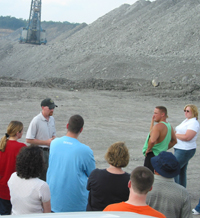Teachers Learn Environment Lessons They'll Give to High School Students
Teachers Learn Environment Lessons They'll Give to High School Students

A surface mine in eastern Kentucky recently served as an outdoor classroom for a group of master’s degree students from the University of Kentucky College of Education.
The students, who are preparing for high school teaching, learned about mining and energy production, land reclamation, geology and other aspects of natural resource preservation. The group’s three-day visit to Perry and Breathitt Counties, which also included instruction at UK’s Robinson Forest, was designed to provide real-world experience they can pass along to their own students.
“We feel like environmental education is a good interdisciplinary approach to teaching so we’re trying to introduce a lot of different types of teachers to this,” said Truman Stevens, department chair of curriculum and instruction in the UK College of Education. “The ultimate goal here is to provide environmental and energy education experiences for kids in the schools.”
Teachers participating in this special environment program have a variety of academic specialties, including math, science, social studies and foreign language.
Tina Hawley, an earth science teacher from Lexington, said it doesn’t matter what major the participating teachers have because energy and natural resources are important topics for everyone. She said the trip to eastern Kentucky encourages her to perhaps take her own students on a similar trip.
“I can definitely use this either on a field trip to have them come out and search for fossils at a certain mine site, or talk about the impacts of environmental geology and strip mining on the environment and how mines actually rebuild the environment once they’re finished mining it,” Hawley said.
William Henderson, a math teacher also from Lexington, said the experience gives him another teaching tool to use in the classroom.
“I can go back to the city and share information with students who normally might not find out or have any knowledge of what a coal mine is or the mining processes used,” said Henderson.
At Robinson Forest the group heard presentations about forest plants and animals from Cooperative Extension specialists in the UK College of Agriculture. The environment program received part of its financial support through Extension and UK’s Tracy Farmer Center.
“Blake Newton presented facts on bugs in the forest, Tom Barnes gave an overview on flora and fauna and Doug McLaren presented information on using global positioning systems,” said Carol Hanley, a 4-H youth development specialist who helped coordinate the trip. “Cooperative Extension is always a great place to go when you think about natural resource education and providing support.”
Hanley said many of the teachers brought digital cameras or recorders to the mine and forest visit so their students can “live the experience” vicariously through the images and sounds their instructors captured during the trip.
Collaborating agencies for the environment program include Kentucky Geological Survey, the Kentucky NEED Project, Kentucky Department of Fish and Wildlife, U.S. Department of Education, Murray State University, Fayette County Schools, Kentucky Author, UK Department of Curriculum and Instruction, UK Tracy Farmer Center for the Environment, UK Cooperative Extension, Starfire Mine and Robinson Forest.
